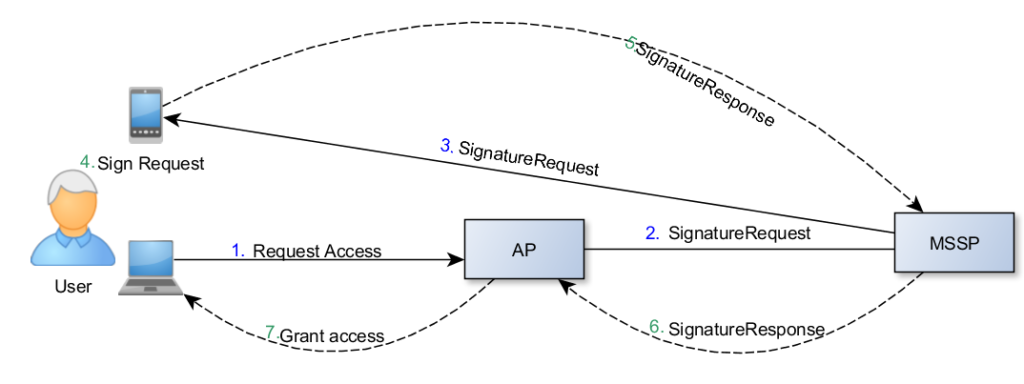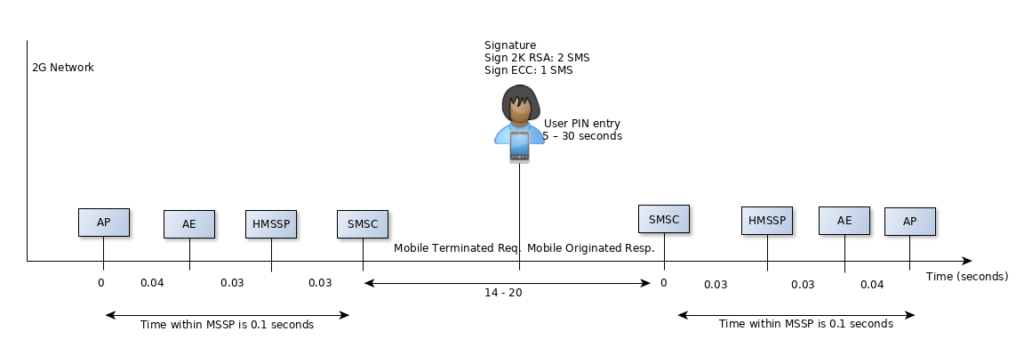Mobile ID is a service that relies heavily on SMS latency. The motivation of this blog post is to show an estimation of the time to complete a Mobile ID transaction using SMS in some mobile network technologies like 2G, 3G, and 4G.
The following figure describes the flow of a typical user authentication in a Mobile ID service:

Figure 1: Example Mobile ID Transaction flow
When an Application Provider service requests user authentication from the MSSP (2), the MSSP sends a mobile signature request via a SMSC to the end user device (over the air, 3.) After signing, a SIM card creates a response and sends it back to the MSSP via the SMSC (4).
Considering that users are often impatient and cannot tolerate long wait times in between request and response flows (access request and access granted), the Mobile ID service response time matters.
Mobile ID responsiveness
Responsiveness of a Mobile ID service is hugely influenced by:
- Mobile network technology standard (4G, 3G, 2G)
- Number of SMS (especially the length of the DTBS/DTBD).
- Mobile network and service quality
The network technology standard specifies the latency and bandwidth of the network, which determines how fast an SMS message is delivered over the network. The latency of an SMS message in 2G is understandably higher than the latency in newer standards such as 3G or 4G.
The number of SMS is dependent on the cryptographic technology in use. On the Alauda P38 Lighting SIM card applet the number of request SMSs is 1, and number of response SMSs is 1 for 256 bit ECDSA signatures to 2 for 2kb RSA signatures.
Additionally, if the SMSC does a store-and-forward handling of the messages, it increases delivery latency both ways.
Other factors, which may influence responsiveness to a certain degree include:
- Network signal strength
- Mobile device attributes such as mobile OS etc.
The table below shows Mobile ID performance figures in different mobile network technology standards, using 2K RSA. These figures have been measured in DNA network, Espoo, Finland, 2017.
| Mobile Network Technology | Round-trip time, seconds |
|---|---|
|
4G |
4 – 7 |
|
3G |
6 – 9 |
|
2G |
14 – 20 |
Table 1: Estimated Mobile ID SMS Round-Trip Times (Finland)
Table 1 above and figure 2 below, show that the transaction time in the Kiuru MSSP platform is more or less negligible, with complete round-trip time (Signature request and responses) in the MSSP, only a fraction of a second (200 milliseconds). The bottleneck is the network latency. The round-trip time varies between 4 – 7 seconds in 4G, and 14 – 20 seconds in 2G.

Figure 2: Mobile ID transaction times (graph)
Below is the figure obtainable in Switzerland (Swisscom, Zürich, 2017) using the Swiss Mobile ID. Time measurements have been done with higher resolution.
| Mobile Network Technology | Round-trip time, seconds |
|
4G |
3.2 |
|
3G |
5.0 |
|
2G |
14.3 |
Table 2: Mobile ID Communication Round-trip Times (Switzerland)
As shown in the above table, the importance of the mobile network standard in use cannot be over emphasized, with performance improvement of 11 seconds from 2G to 4G.
We understand that from the user’s perspective, user experience deteriorates quickly once it exceeds 20 seconds to authenticate to an AP’s service. Therefore we have worked to reduce the number of SMS messages to a minimum, such that the user wait time is as small as possible.
On the average, we estimate that the maximum wait time should not exceed 8 seconds in 2G, 5 seconds in 3G and 3 seconds using 4G network, irrespective of if 2K RSA or ECC is used.
Future of SMS
There are two future directions for SMS based communication:
- SMS-over-IP [ETSI TS 124 341]
- The 5G network
The SMS-over-IP offers as fast communication as the underlying network technology itself.
The 5G network offers extremely low latency. In 5G network our expectation is less than 2 seconds round-trip.
Written and Edited by: Eemeli Miettinen
